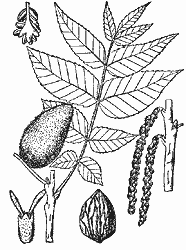 Butternut
Butternut
Juglans cinerea L. (Juglandaceae)
Common Names
Butternut, filnut, lemonnut, oilnut, white walnut.
Description
A tree usually 40 to 60 feet in height, with light gray bark divided into broad, flat ridges by moderately deep furrows. Leaves are compound with 11 to 17 leaflets arranged opposite each other, from 2 to 3 inches long, and with very short stems. Elliptical pointed fruit is 1 ½ to 2 ½ inches long and occurs in clusters of 2 to 5 or singly. The strong smelling, sticky husk is covered with hairs and contains an edible nut that has a hard, thick, deeply furrowed shell.
Flowering Period
April to June.
Habitat
Rich woods and along rivers on well drained soils.
Harvest
Inner bark of root any time of year; leaves and nuts in the fall.
Uses
The bark has been used as a rubifacient and cathartic. Oil extracted from the fruit is reportedly valuable in treating tape worms and fungus infections. In Appalachia, a tea made from the bark is used as a laxative.